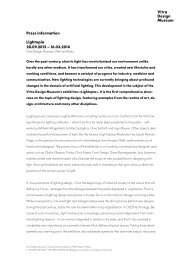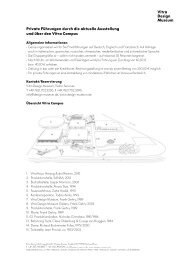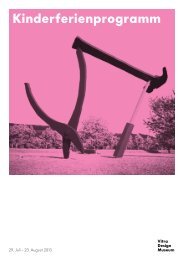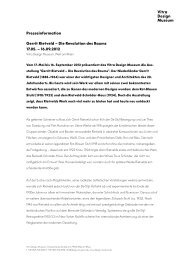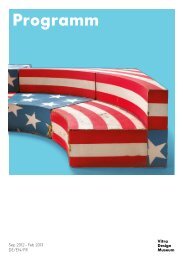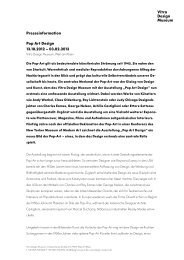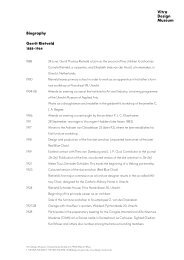Lightopia Programm - Vitra Design Museum
Lightopia Programm - Vitra Design Museum
Lightopia Programm - Vitra Design Museum
Create successful ePaper yourself
Turn your PDF publications into a flip-book with our unique Google optimized e-Paper software.
Bulb, Ingo Maurer, 1966<br />
»The quality of light<br />
is more important to<br />
me than its form.«<br />
Ingo Maurer (born 1932) has been one of the<br />
world’s leading figures in the field of lighting<br />
design for decades. Curator Jolanthe<br />
Kugler spoke with him about his oeuvre<br />
and the evolution of lighting design.<br />
For almost fifty years, you have introduced surprising<br />
new designs on an annual basis. What<br />
brought about the design of your very first lamp?<br />
I had just received a commission that took me<br />
to Venice. While I was there I enjoyed a wonderful<br />
meal and drank a whole bottle of red<br />
wine with it. Then I went up to my room and<br />
there was this naked light bulb hanging there.<br />
It was like a ... coup de foudre! Still half drunk,<br />
I drew a sketch of a lamp. The next day I travelled<br />
to Murano with this idea in my pocket. When<br />
I got home, I designed a base made of pressed<br />
metal to go with it: the Bulb lamp was born!<br />
How did things develop after that?<br />
At that point in time, I still placed a great emphasis<br />
on the form of an object, similar to great<br />
Italian designers like Achille Castiglioni and<br />
Vico Magistretti. But I noticed quite quickly that<br />
the quality of light is more important to me than<br />
the form, and so I began to concentrate on that.<br />
Then my fan lamps (Uchiwa I, 1973) came into<br />
fashion – also an interesting story. I travelled to<br />
Japan and met a great master of fan artistry,<br />
Shigeki-San. Even though we couldn’t talk to each<br />
other, there was an amazing intuitive understanding<br />
between us. This is how I slipped into<br />
Japanese culture, and that brought me even<br />
closer to the topic of light.<br />
For every important theme in the past fifty years<br />
of lighting design, your workshop has made some<br />
technical contribution or introduced a stylistic innovation.<br />
Where did you get the idea for YaYaHo?<br />
That was on a New Year’s morning in Haiti,<br />
where I was staying with friends. There was a<br />
small outdoor square with a huge hanging light<br />
bulb welded directly to the wire, without a plug<br />
or any other connection. I was so entranced by<br />
it, so fascinated, that I wanted to make something<br />
like it. When I got back to New York, we<br />
started experimenting with the idea, stretching<br />
cables to see what it might look like.<br />
In your designs, the most innovative technology<br />
is very often combined with conventional lighting<br />
typologies or archaic light sources, like My<br />
New Flame (with Moritz Waldemeyer, 2012)...<br />
That mostly happens on an unconscious level;<br />
generally I’m far removed from intellectual considerations...<br />
<strong>Design</strong>s with new technologies<br />
emerge from experimentation. One time, when<br />
I made a sketch of a chandelier on a napkin,<br />
I started to think: this should really shine and<br />
sparkle. That’s how we arrived at the LEDs, a<br />
technology that had already been developed<br />
by General Electric in 1906. But collaboration<br />
with other people is also important – it leads to<br />
new ideas and new approaches, like My New<br />
Flame (2012) with Moritz Waldemeyer.<br />
Along with LEDs, we also observe an increasing<br />
use of OLED lamps. Do you see a great future in<br />
this development?<br />
This definitely presents new challenges for lighting<br />
design. For example, one could create works<br />
with a strong graphic character. I would use<br />
OLEDs in combination with another light source<br />
or as an integrated part of a colourful surface, in<br />
a very playful way. I am currently working on a<br />
new design with OLEDs which is actually conceived<br />
as an outdoor product. I have already<br />
found a solution for the technical requirements,<br />
but I still need to work on the design aspects...<br />
« La qualité de la<br />
lumière m’importe<br />
plus que la forme. »<br />
Ingo Maurer (*1932) se place depuis des<br />
décennies au rang des designers lumineux<br />
les plus remarquables sur la scène mondiale.<br />
Jolanthe Kugler, commissaire, s’est<br />
entretenue avec lui sur ses travaux et<br />
l’évolution du design lumineux.<br />
Voilà près de 50 ans que vous nous surprenez<br />
chaque année avec de nouveaux projets. Comment<br />
votre premier design de lampe vous est-il venu ?<br />
J’avais une mission pour laquelle j’ai dû me<br />
rendre à Venise. La nourriture était formidable<br />
et j’ai bu une bouteille entière de vin rouge. Puis<br />
je suis retourné dans ma chambre et j’ai vu<br />
pendre cette ampoule nue. Ça a été comme<br />
un… coup de foudre ! Encore à moitié enivré, j’ai<br />
dessiné l’image de cette lampe. Le lendemain,<br />
je suis allé à Murano avec cette idée dans ma<br />
besace. De retour chez moi, j’y ai ajouté le pied<br />
en métal chromé et voilà ! « Bulb » était né !<br />
Comment s’est passée la suite ?<br />
À cette époque, la forme avait encore beaucoup<br />
d’importance pour moi, comme c’est le<br />
cas pour les grands designers italiens, Achille<br />
Castiglioni et Vico Magistretti notamment. J’ai<br />
cependant rapidement remarqué que la qualité<br />
de la lumière m’importait plus que la forme et je<br />
me suis concentré là-dessus. Puis la mode s’est<br />
intéressée à mes lampes-éventail (Uchiwa I, 1973),<br />
une histoire très intéressante d’ailleurs. Je suis<br />
allé au Japon et j’ai rencontré un artisan spécialiste<br />
de la création d’éventails, Shigeki-San. Sans<br />
parler la même langue, nous nous comprenions<br />
intuitivement incroyablement bien. C’est comme<br />
ça que je suis tombé dans la culture japonaise<br />
et que je me suis encore approché de la lumière.<br />
Pour chacun des thèmes développés au cours des<br />
50 dernières années, votre atelier a été à l’origine<br />
d’innovations, tant sur le plan technique que sur<br />
la forme. Qu’en est-il en ce qui concerne YaYaHo ?<br />
C’était le matin du Nouvel An, que j’avais passé à<br />
Haïti avec des amis. Il y avait là-bas une petite<br />
place où pendait une énorme ampoule accrochée<br />
à un câble, sans douille ou autre connecteur. Ça<br />
m’a plongé dans une sorte de transe, j’étais tellement<br />
impressionné que j’ai voulu en faire quelque<br />
chose. De retour à New York, j’ai commencé à faire<br />
des essais de tension de fils pour voir ce à quoi cela<br />
pouvait ressembler.<br />
Dans vos projets, il arrive souvent que les techniques<br />
les plus modernes côtoient les typologies<br />
de lampes les plus traditionnelles ou les agents<br />
lumineux les plus archaïques, comme dans My<br />
New Flame (avec Moritz Waldemeyer, 2012)…<br />
Tout ceci est bien involontaire, en réalité, je me<br />
trouve très éloigné des considérations intellectuelles…<br />
C’est par l’expérimentation que les<br />
nouvelles technologies trouvent leur place<br />
dans mes projets. Alors que j’avais crayonné un<br />
lustre sur une serviette, j’ai pensé qu’il faudrait<br />
le faire briller et miroiter. C’est comme ça que<br />
nous sommes arrivés aux LEDs, une technique<br />
inventée dès 1906 par General Electric. Mais<br />
ce qui compte par-dessus tout, c’est la collaboration<br />
avec d’autres personnes, aux approches<br />
et idées nouvelles, comme dans le cas de My<br />
New Flame (2012) avec Moritz Waldemeyer.<br />
Après les LEDs, ce sont de plus en plus les OLEDs<br />
qui sont employées. La tendance a-t-elle un bel<br />
avenir d’après vous ?<br />
Ces nouveaux enjeux de création sont très certainement<br />
à prendre en considération. On pourrait<br />
par exemple travailler dessus sur le plan graphique.<br />
Je combinerais les OLEDs avec un autre type de<br />
lumière, ou sur une surface colorée, de manière<br />
ludique. Je travaille actuellement sur un nouveau<br />
projet avec des OLEDs, pour l’extérieur. Pour la<br />
mise en œuvre technique, j’ai la solution, mais je<br />
dois encore peaufiner la forme…<br />
17



